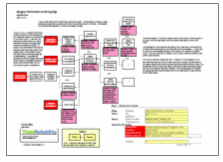The number of food recalls in the news lately is enough to make you lose your appetite.
Let’s start by focusing on just one of the recent recalls. Listeria from contaminated cantaloupe has caused at least 15 deaths and has sickened more than 80 across the USA. Tests have traced the listeria back to a single farm in Colorado, but the source has not yet been identified.
Listeria is a common, but potentially deadly bacteria that can be found in soil, water, decaying plant matter and manure so the potential sources are numerous. Another important piece of information is that Listeria can be difficult to eliminate once it has spread to distribution and processing facilities because it grows well at low temperatures, unlike most bacteria. Listeria can continue to grow in refrigerated areas where fruit maybe stored or processed.
 Finding the source of a listeria outbreak can also be difficult because it can take up to two months for an individual to become sick. Adding to the complexity of identifying what food is causing an outbreak of listeria is the wide variety of foods that can become contaminated. Listeria can be found in meat, dairy, fruits and vegetables.
Finding the source of a listeria outbreak can also be difficult because it can take up to two months for an individual to become sick. Adding to the complexity of identifying what food is causing an outbreak of listeria is the wide variety of foods that can become contaminated. Listeria can be found in meat, dairy, fruits and vegetables.
Even once the source of contamination has been identified, it can be difficult to effectively remove the item from the food supply. In this example, the sheer number of cantaloupes involved as well as a long supply chain made it difficult to remove all contaminated melons. The farm recalled their entire 2011 cantaloupe crop which was more than 300,000 cases distributed from the end of July to mid-September. The cantaloupes were shipped to 25 states and sold through many different retailers.
A recent article by CBS stated that the average cantaloupe makes four or five stops on the way to the super market shelves. Typical cantaloupes will go to a packing house for cleaning and packing, a distributors, a retail distribution center and finally a grocery store before they make it to the consumer. This makes it very difficult to identify where a food might have been contaminated.
Click on “Download PDF’ above to view a high level Cause Map of this issue. A Cause Map is an intuitive form of root cause analysis that visually lays out the causes that contribute to an issue.








